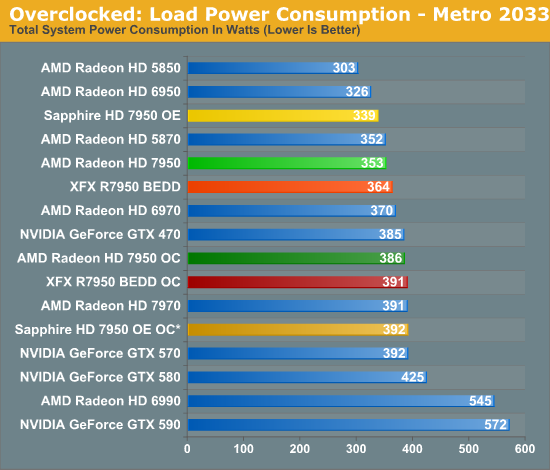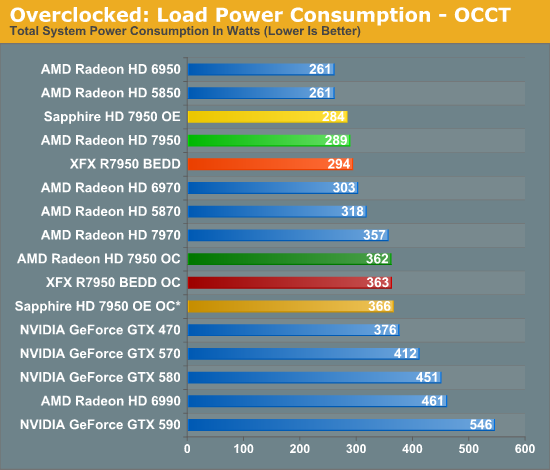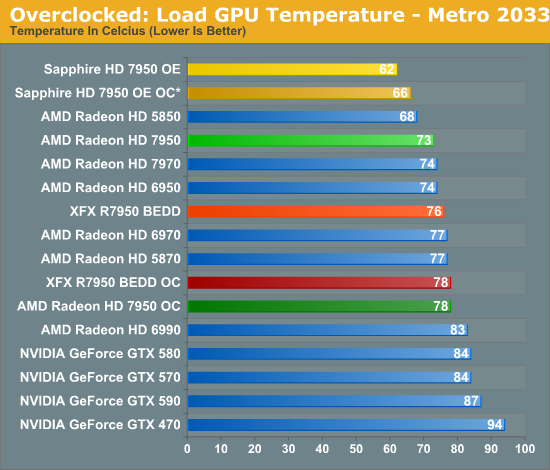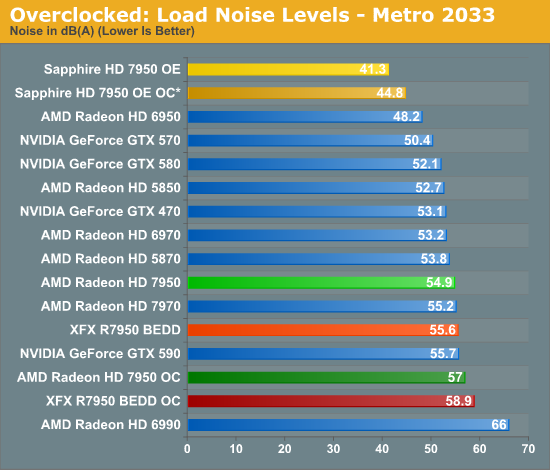AMD Radeon HD 7950 Review Feat. Sapphire & XFX: Sewing Up The High-End Market
by Ryan Smith on January 31, 2012 9:02 AM ESTOverclocking: Power, Temp, & Noise
In their marketing materials AMD is heavily pushing overclocking, and they have good reason to. With the 7970 we’ve established that Tahiti has quite a bit of overclocking headroom, and as the 7950 is clocked lower by default this opens up that headroom even further. Realistically AMD’s binning process means that the best clocking Tahiti GPUs are going to be allocated to the 7970 unless they have failed shaders, but even with that there’s quite a bit of potential on paper.
As with overclocking the 7970, our goal overclocking the 7950 is to see how much you can get for free; that is without any voltage adjustments. AMD’s reference PCBs are not particularly overbuilt for overclocking—cards like that will come later—so sticking to the reference voltage is the safest option, not to mention the easiest. With the 7970 we were able to get 200MHz (22%) overclocks without any voltage adjustment, and we’re hoping for the same out of the 7950.
With that said, we quickly ran into a wall on one card: the Sapphire 7950. Sapphire’s low VID of 0.993v may be great for temperature and noise at stock, but it’s not doing overclocking any favors. We only hit 950MHz at that voltage. As the Sapphire was the odd man out—every other card was at 1.093v—we did end up overvolting the Sapphire to 1.093v to see what it was capable of when put on similar footing as the rest of our cards.
After bringing up the voltage of our Sapphire card, all of our 7950s ended up overclocking to very similar levels. Our Sapphire and AMD cards topped out at 1025MHz core, a 225MHz (28%) overclock over a stock 7950 and a 125MHz (14%) overclock over the Sapphire’s factory overclock, while our XFX card reached 1050MHz, a 150MHz (17%) overclock beyond XFX’s factory overclock. Meanwhile the memory clocks on all of our cards topped out at 5.8GHz, beyond which we’d start seeing performance regressions from error correction on the memory bus.
| Radeon HD 7950 Overclocking | |||||
| AMD Radeon HD 7950 | Sapphire HD 7950 Overclock Edition | XFX R7950 BEDD | |||
| Shipping Core Clock | 800MHz | 900MHz | 900MHz | ||
| Shipping Memory Clock | 5GHz | 5GHz | 5.5GHz | ||
| Shipping Voltage | 1.093v | 0.993v | 1.093v | ||
| Overclock Core Clock | 1025MHz | 1025MHz | 1050MHz | ||
| Overclock Memory Clock | 5.8GHz | 5.8GHz | 5.8GHz | ||
| Overclock Voltage | 1.093v | 1.093v | 1.093v | ||
As you can imagine, with such similar overclocks, gaming performance on all 4 cards ended up being very similar. So we’ll get to gaming performance in a minute, while we’ll start with power, temperature, & noise.


Even though we’re not increasing the voltage on our AMD and XFX cards, merely overclocking them and raising the PowerTune limit to avoid throttling does drive the power consumption up. As is typical with heavily overclocked cards, overclocking quickly drives up power consumption and the 7950s are no exception. After overclocking power consumption is almost identical to the stock 7970, so while you can get 7970 performance you still need to pay the price with 7970 power consumption. Meanwhile it’s interesting to note that even with the extra 0.1v we’ve given the Sapphire card its final power consumption is only ever so slightly higher than the other 7950s, proving that voltage is the great equalizer in this case.


With the increase in power comes an increase in temperatures. The Sapphire card still does very well here staying in the low 70s even under OCCT, while the reference and XFX cards hit the high 70s under Metro and mid 80s under OCCT. As we’ve yet to really ascertain what the thermal limits are for Tahiti, it’s not clear whether there’s too much thermal headroom left for the GPU, particularly under OCCT.


Last but not least we have load noise. The Sapphire card is once more a stellar performer, and we still can’t get it above 50dB even with OCCT. Unfortunately the XFX 7950 BEDD has its biggest fallout yet—it may be able to overclock well, but at 64dB under OCCT the performance isn’t going to be worth the immense amount of noise it creates to move enough air to keep the GPU cool.










259 Comments
View All Comments
Galidou - Sunday, February 5, 2012 - link
Oh wait, wait, the 9800gx2 was priced 150$ lower than the GTX 280 and was performing more than gtx 280!! LOL speak about mispricing.... LOL OMG THAT'S RIDICULOUSGalidou - Sunday, February 5, 2012 - link
LOL that 7970 story pricing like it was the worst decision a Video card manufacturer ever made is so ridiculous chizow, it'S not a good decision either, we would all like to see lower prices considering we know the size of the die under the hood and we know it can be priced lower.But that GTX 280 thingy because Nvidia was thinking they had no competition was a little like taking people for DUMMIES. The radeon 4870 wasn't so mispriced, it was the gtx 280 that WAS. The GTX was uber big but didn'T justify over triple the price of 8800gt or higher price than a 9800gx2 considering the performance of those parts..... HELL NO.
In the end, I prefer a pricing according to performance than being taken for a DUMMY by a company leading the technology with a little more performance...
chizow - Sunday, February 5, 2012 - link
Like I said Galidou, the GTX 280 absolutely earned the original MSRP. It was a true flagship card in every respect and maintained the price:performance increase you would expect from a new next-gen GPU over its predecessor.You still haven't refuted this because again, the data is all out there. It was over 1.5x faster than the 8800GTX/9800GTX and roughly the same speed as the 9800GX2, the minimum baseline expectations anyone should have for a new flagship card on a new arch/gen/process.
AMD was the one who mispriced their card at the time they could least afford to do so. Some like myself argued they just didn't know how to make money. They could've easily priced it at $400 and STILL forced Nvidia to drop prices on the GTX 280 and especially the GTX 260.
But yes, Nvidia looked horrible after that decision but did right by their customers by issuing rebates. Now AMD is in the exact same position and stands to look badly with this pricing. Do you really think they will do the same if Nvidia forces them to cut prices on these parts? Its OK, you can say a bad thing about AMD too. ;)
chizow - Sunday, February 5, 2012 - link
We've already covered this, because with the exception of very rare and extraordinary increases like the 8800GTX or 9700pro, 2x increases over last-gen flagships are NOT normal.The GTX 280 was easily 2x faster than the 8800GT, but the 8800GT was a refresh mid-range performance product. Whatever price:performance discount it carried already existed compared to the high-end parts of the time like the 9800GTX and 9800GX2, where it cost significantly less for excellent performance.
Similarly, in these last few generations of cards mid-range cards like the GTX 460 and GTX 560 can be had for less than half of what a GTX 480 or GTX 580 cost but they perform much better than the cost would indicate. Obviously the top Kepler does not need to be 3x faster than the GTX 560 in order to command a $500 price tag commensurate with the flagship slot.
In summary, the top cards do command a premium and determine the pricing for all cards that follow, but their merit for commanding that top price is judged against previous cards and generations.
Its already become obvious that 15-25% increase from Tahiti over Fermi doesn't carry enough mustard to push the stack, since its momentum wasn't enough to even shift the metric at the second stop, the 7950.
Galidou - Sunday, February 5, 2012 - link
It was the same performance than a 9800gx2 when it was in 2560* resolution because of memory, for the rest(99.5% of the people with 1080p or less back then) the 9800gx2 was truncating the gtx280 for 150$ less.chizow - Sunday, February 5, 2012 - link
No it was trading blows with the 9800GX2 and beating it at the highest resolutions and AA settings that mattered for people looking to upgrade.This is going to happen with any new flagship part because of the overall increased pipeline. High-end cards are meant to push high-end settings and resolutions because what you have is usually enough at lower end settings. This is why we "upgrade".
Regardless, X2 parts are always going to carry some performance advantage at cheaper prices but that's because single-GPU always carries a premium that goes with being the top single-GPU flagship.
You can look at any forum and you see this decision making process all the time with both last-gen GPUs and newer ones.
But back to the point. Flagship next-gen GPUs do generally tend to compete with last-gen X2 in performance, not always a convincing win across the board, but enough to effectively retire those cards. That's clearly not the case with the 7970.
Galidou - Sunday, February 5, 2012 - link
Nope you still can,T say something wrong about Nvidia you corrected them by saying they issued rebates to their customers, and AMD is not in the same position, they did not price it for dummies, it'S accordingly to it'S performance... wow when will you realize triple the price and according to it'S performance is different? that's all I wan you to say lol!chizow - Sunday, February 5, 2012 - link
Is the 7970 triple the performance of the 6950? So then how does it justify 3x the price?Its amazing how you want to try to hold Nvidia to this flawed logic and dismiss it when the 7970 fails even WORST at meeting it.
Again, this just makes you look incredibly stupid or incredibly dishonest, neither of which are flattering.
Galidou - Sunday, February 5, 2012 - link
it'S not triple the price of 6950 it's a LITTLE more than double, fi you have to lie this discussion is over..... when I said triple the price of the 8800gt I was gentle, 650$ for gtx 280 while 8800gt were selling for I remember I got one for 180$ so that's in fact three times and a half, plus we're comparing a 1gb video card price to a 3gb while GTX 280 and 8800gt had 256mb difference.... Now that I see you have to lie I don't want to continue this, I may be not right in EVERYTHING I say but I ain't lying big time....I prefer to be honest in my opinion than being dishonest in a certitude.....
Ati radeon 3870 sucked big time, they never offered as good a competition to Nvidia after the X1xxx products in my opinion and Nvidia have(most of the time) got better drivers, I prefer their interface, I dislike catalyst. Here's what I have to say about ATI and I have not much wrong about Nvidia but at least I can say I see both side of the medal.
Good luck in the future, peace out.
Galidou - Sunday, February 5, 2012 - link
I was offering you my perception ok I played the troll but I never lacked respect to you, I'm not saying you are stupid or anything while you did, respect is something you can't buy.I may be poking your opinions because you see them as fact but thing is perception is different for everyone. I do not see anything SO wrong in the pricing of the 7970 while you obviously see something very bad in it. I can'T make you see my point of view so I guess you and I are right, depends for who reads us.
respect.